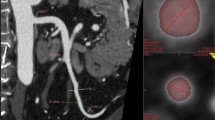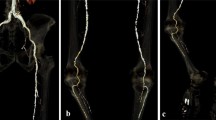Abstract
Purpose
This study was designed to evaluate CO2 computed tomography angiography (CO2-CTA) of the iliac and lower limb arteries in patients with contraindications for iodinated contrast agent (ICA).
Methods
Five patients with contraindications for ICA were examined using CO2-fluoroscopic enhanced angiography (CO2-FLA) and CO2-CTA using a high-pitch examination protocol. Objective (vessel diameter) and subjective (visual score) image quality parameters were evaluated. Pathological findings in both modalities were compared.
Results
CO2-CTA was feasible in all patients without adverse side effects, except for CO2 injection-associated pain. Objective vessel analysis revealed no significant difference in diameters as determined by CO2-CTA and CO2-FLA (0.44 ± 0.4 and 0.46 ± 0.41 mm, p = 0.93). CO2-CTA had on average a higher image-quality score (2.6 ± 1.0 vs. 2.3 ± 1.0, p = 0.009). While for pelvic and upper leg CO2-CTA advantageous (3.1 ± 0.74 vs. 2.7 ± 0.9, p = 0.0014) at good quality scores, for calf vessels no significant improvement was visible (1.9 ± 1.0 vs. 1.7 ± 0.9, p = 0.49) and scores were poorer.
Conclusions
CO2-CTA with high-pitch CT was feasible in a limited number of patients. Image-quality scores were on average higher for CO2-CTA than for CO2-FLA, while limited imaging quality in the vessels below the knee needs further work on the CT protocol. An added value of cross-sectional imaging was apparent but needs further quantification.




Similar content being viewed by others
References
Akaeda T, Isaka K, Nakaji T, Kakizaki D, Abe K (2005) Clinical application of virtual hysteroscopy by CO2-multidetector-row computed tomography to submucosal myomas. J Minim Invasive Gynecol 12(3):261–266
Bae KT, Hong C, Becker CR et al (2003) CO2-enhanced CT imaging for the detection of pulmonary emboli: feasibility study in a porcine model. Acad Radiol 10(3):313–320
Barrett BJ, Katzberg RW, Thomsen HS et al (2006) Contrast-induced nephropathy in patients with chronic kidney disease undergoing computed tomography: a double-blind comparison of iodixanol and iopamidol. Investig Radiol 41(11):815–821
Cohnen M, Vogt C, Beck A et al (2004) Feasibility of MDCT colonography in ultra-low-dose technique in the detection of colorectal lesions: comparison with high-resolution video colonoscopy. Am J Roentgenol 183(5):1355–1359
Dahm JB, Vogelgesang D, Hummel A, Staudt A, Volzke H, Felix SB (2002) A randomized trial of 5 vs. 6 French transradial percutaneous coronary interventions. Catheter Cardiovasc Interv 57(2):172–176
Dill KE, Rybicki FJ, Desjardins B et al (2012) American College of Radiology appropriateness criteria: claudication-suspected vascular etiology acr appropriateness criteria. American College of Radiology
Fleischmann D (2010) CT angiography: injection and acquisition technique. Radiol Clin N Am 48(2):237–247, vii
Greenspon AJ, Patel JD, Lau E et al (2012) Trends in permanent pacemaker implantation in the United States from 1993 to 2009: increasing complexity of patients and procedures. J Am Coll Cardiol 60(16):1540–1545
Hawkins IF, Caridi JG (1998) Carbon dioxide (CO2) digital subtraction angiography: 26-year experience at the University of Florida. Eur Radiol 8(3):391–402
Hope TA, Herfkens RJ, Denianke KS, LeBoit PE, Hung YY, Weil E (2009) Nephrogenic systemic fibrosis in patients with chronic kidney disease who received gadopentetate dimeglumine. Investig Radiol 44(3):135–139
Kessel DO, Robertson I, Patel JT et al (2002) Carbon-dioxide-guided vascular interventions: technique and pitfalls. Cardiovasc Interv Radiol 25(6):476–483
Kian K, Wyatt C, Schon D, Packer J, Vassalotti J, Mishler R (2006) Safety of low-dose radiocontrast for interventional AV fistula salvage in stage 4 chronic kidney disease patients. Kidney Int 69(8):1444–1449
Laskowski I, Verhagen HJ, Gagne PJ, Moll FL, Muhs BE (2007) Current state of dynamic imaging in endovascular aortic aneurysm repair. J Endovasc Ther 14(6):807–812
Mahnken AH, Bruners P, Mommertz G et al (2008) Carbon dioxide contrast agent for CT arteriography: results in a porcine model. J Vasc Interv Radiol 19(7):1055–1064
Mahnken AH, Chalabi K, Jalali F, Gunther RW, Buecker A (2004) Magnetic resonance-guided placement of aortic stents grafts: feasibility with real-time magnetic resonance fluoroscopy. J Vasc Interv Radiol 15(2 Pt 1):189–195
Mahnken AH, Penzkofer T, Grommes J et al (2010) Carbon dioxide-enhanced CT-guided placement of aortic stent-grafts: feasibility in an animal model. J Endovasc Ther 17(3):332–339
Marenzi G, Assanelli E, Campodonico J et al (2009) Contrast volume during primary percutaneous coronary intervention and subsequent contrast-induced nephropathy and mortality. Ann Intern Med 150(3):170–177
Ouwendijk R, de Vries M, Pattynama PMT et al (2005) Imaging peripheral arterial disease: a randomized controlled trial comparing contrast-enhanced MR angiography and multi-detector row CT angiography. Radiology 236(3):1094–1103
Pannu N, Wiebe N, Tonelli M, Alberta Kidney Disease Network (2006) Prophylaxis strategies for contrast-induced nephropathy. JAMA 295(23):2765–2779
Penzkofer T, Slebocki K, Grommes J et al (2013) Carbon dioxide-contrasted computed tomography angiography: high pitch protocols and adapted injection parameters improve imaging quality. Rofo-Fortschr. Gebiet Rontgenstrahlen Bildgeb Verfahr 185(2):128–135
Renapurkar RD, Setser RM, O’Donnell TP et al (2012) Aortic volume as an indicator of disease progression in patients with untreated infrarenal abdominal aneurysm. Eur J Radiol 81(2):e87–e93
Rydahl C, Thomsen HS, Marckmann P (2008) High prevalence of nephrogenic systemic fibrosis in chronic renal failure patients exposed to gadodiamide, a gadolinium-containing magnetic resonance contrast agent. Investig Radiol 43(2):141–144
Saam T, Ferguson MS, Yarnykh VL et al (2005) Quantitative evaluation of carotid plaque composition by in vivo MRI. Arterioscler Thromb Vasc Biol 25(1):234–239
Schroeder S, Kopp AF, Baumbach A et al (2001) Noninvasive detection and evaluation of atherosclerotic coronary plaques with multislice computed tomography. J Am Coll Cardiol 37(5):1430–1435
Solomon R, Dumouchel W (2006) Contrast media and nephropathy: findings from systematic analysis and Food and Drug Administration reports of adverse effects. Investig Radiol 41(8):651–660
Spuentrup E, Ruebben A, Mahnken A et al (2005) Artifact-free coronary magnetic resonance angiography and coronary vessel wall imaging in the presence of a new, metallic, coronary magnetic resonance imaging stent. Circulation 111(8):1019–1026
Sun ZH (2006) Diagnostic accuracy of multislice CT angiography in peripheral arterial disease. J Vasc Interv Radiol 17(12):1915–1921
Thomsen HS, Morcos SK (2009) Risk of contrast-medium-induced nephropathy in high-risk patients undergoing MDCT—a pooled analysis of two randomized trials. Eur Radiol 19(4):891–897
Acknowledgments
The study was supported within the RWTH Aachen University Hospital START Program and the German Society of Vascular Surgery and Vascular Medicine (Deutsche Gesellschaft für Gefäßchirurgie und Gefäßmedizin DGG).
Conflict of interest
Tobias Penzkofer reports travel support from Siemens Healthcare and Philips Healthcare, outside the submitted work. The Department of Diagnostic and Interventional Radiology, RWTH University Hospital Aachen has a research agreement with Siemens Healthcare, Germany. Karin Slebocki, Jochen Grommes, Philipp Bruners, Peter Isfort, Stephane Langer, Christiane K. Kuhl and Andreas H. Mahnken have nothing to disclose. Thomas Schmitz-Rode is inventor of the CO2 injection device used in the study.
Author information
Authors and Affiliations
Corresponding author
Rights and permissions
About this article
Cite this article
Penzkofer, T., Slebocki, K., Grommes, J. et al. High-Pitch Carbon Dioxide Contrasted CT Angiography: Pilot Study. Cardiovasc Intervent Radiol 37, 362–370 (2014). https://doi.org/10.1007/s00270-013-0834-5
Received:
Accepted:
Published:
Issue Date:
DOI: https://doi.org/10.1007/s00270-013-0834-5




